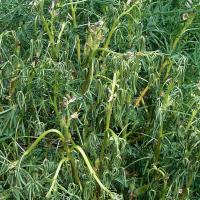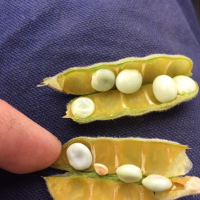Diagnosing frost in narrow-leafed lupins
Narrow-leafed lupins tolerate frost in early growth stages but are susceptible when growing rapidly from flowering to early pod fill.
What to look for
- Low lying areas, light-coloured soil types, dry soil, and areas with more retained stubble are likely to be more damaged.
Paddock
- Plants with wilted upper foliage that shrivels and dies, or blistered pods.
- These frozen upper stems become discoloured (dark green directly after thawing) and associated foliage shrivels and dies.
- Often the damaged tissue (stem and pods) will take on a brown colour due to bacterial fungal infection.
- Stems have surface splits that turn brown with a mushy interior.
- Pods have pale surface spots or blisters and brown mushy lesions.
- Developing pods abort and fall off.
- Developing seed may abort.
- Unaffected parts of the plant grow, flower and set seed if there is sufficient time and soil moisture.
Plant
What else could it be
| Condition | Similarities | Differences |
|---|---|---|
| Diagnosing anthracnose in narrow-leafed lupins | Similar shepherd’s crook symptoms on stems | Brown lesions and pink spores in the bend of the crook |
| Diagnosing group I herbicide damage in narrow-leafed lupins | Bent and twisted plants | Plants pale and slowly die without marked leaf necrosis |
| Diagnosing bean yellow mosaic virus - non necrotic in narrow-leafed lupins | Bent necrotic upper stems | Plants die back from growing point. Usually occurs in patches or edge of paddock |
Where does it occur?

Temperature
- Frost damage occurs when night air temperature falls below -2°C.
- Lupins become more susceptible throughout flowering and bud formation when the plant is rapidly growing.
Management strategies
- Frost damage is irreversible however managing a crop to only avoid frost will come at a yield cost and potentially increased disease risk. It is advisable that after a frost event, to make note of the location and severity, as this will help to inform future crop choice and post frost decisions.
- A comprehensive frost management strategy needs to be part of annual farm planning. It should include pre-season, in-season and post frost event management tactics.
How can it be monitored?
- Check low lying, light coloured soil types and known frost prone areas first. Then check other areas.
- To identify frost damage check for gaps in pod set on the flowering spike and open pods that have a scarred surface to check for mushy, shrivelled or abnormal grain.
See also
Further information
Where to go for expert help
Page last updated: Thursday, 6 July 2017 - 1:01pm






